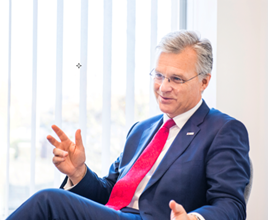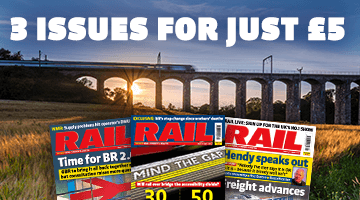But is anybody properly and effectively challenging it?
“Yes, we do need to challenge costs - but if you’re going to have a large piece of infrastructure shut down and lots of possessions for an enhancement, it does make sense to see what other jobs might need to be done at the same time.”
True - but should NR be paying for those extra jobs it wants doing, rather than hanging the cost around the neck of an enhancements project which it never envisaged and may not need those extra aspects?
“I certainly agree that if there is renewal activity that we are wanting to do alongside a specific project, I would not expect the investor to pay for that renewal activity. Absolutely not.”
But this cost-creep is why third-party people say they can’t make the necessary challenge, because that is what happens. They find themselves asked to pay for level crossings or signalling that was never part of their job.
“I think in a way we are sort-of violently agreeing!” he replies. “Part of the problem I have with IP is that I cannot demonstrate to you how efficient it is because there aren’t comparators to benchmark against. So it’s really hard - it’s very easy for people to say you’re too expensive, you’re too slow, because we can’t compare. Hence my desire for contestability.”
He continues: “I’m not reluctant about this - I’m really passionate about it! I WANT it to happen because I passionately believe that if we do not find ways of bringing other investment into the railway, other ways of delivering improvement projects, I fear we won’t be able to deliver the improvements that the network desperately needs.”
All this comes together when Carne talks about his passionate belief in digital signalling for the network as a major contribution towards solving the closely-related congestion, capacity and performance issues bedevilling the industry.
“The Digital Railway programme is about to take off, and in the next Control Period we’re going to see many more digital trains, plus digital control and traffic management. We absolutely desperately need this because our railway is, in many places, chock-a-block. The Chancellor’s announcement of £450m in the Autumn Statement to accelerate the digital programme is hugely exciting, and we should be celebrating that.
“I am really excited about this, but we need to be aware that this is NOT a programme for NR alone. This is an industry change programme, and I don’t believe that NR is the right company to provide all the investment. I want other companies to invest in Digital Railway and I want them to earn a return based on the investment they are prepared to make. So this is where we need to bring different sources of financing and funding to the railway.”
Carne makes an interesting point. In the early days, from an operational point of view trains and track were entirely separate - the driver moved his train according to fixed signals. That started to change after the Grouping, when the Great Western rapidly expanded its rudimentary but very effective Automatic Train Control system, when signalling equipment was carried on trains for the first time on main lines. The British Railways Automatic Warning System extended this, leading to Train Protection Warning System and ultimately Automatic Train Protection.
“Much of the equipment is increasingly on the trains, not the track, and the brains behind that technology exists in the private sector,” says Carne.
“Our whole philosophy for Digital Railway is not to specify how we achieve an increase in capacity, our philosophy is to ask those experts how we should increase the capacity?
“Let them bring their ideas, their technology, and if they believe they can achieve that level of performance improvement, they can put their money where their mouth is. We’ll then give a return based on results - the outcome. They will manage the risk associated with the deployment of their technology.
“I’m not asking them to take risk on existing infrastructure, tunnels, bridges, track - we’ll do that because these companies can’t manage that risk. But they can manage the risk associated with their own technology. They are far better able to do that than we are.
“So that’s what we’re looking at. I’m using the £450m from the Treasury as the starting gun on this journey. This is not a debate anymore - it’s going to happen, so let’s get on with it.”
Now there’s a train of thought which is shot through with as much controversy as clarity. RAIL columnist Christian Wolmar is a passionate opponent of precisely this sort of outsourcing, and it’s difficult - certainly from a traditionalist standpoint - to argue with the view that a railway should be expert about its own signalling. Doubtless Carne would counter that our Air Traffic Control organisation does not manufacture its own digital control equipment, and that in the modern age the railway should follow a similar path. There are other clear benefits, he believes.
“There is also the ability not just to radically improve capacity, but also to improve reliability,” he argues. “How many times do we hear about signal failures causing disruption? Digital technology will improve reliability significantly. We’ll improve safety dramatically, too.”
He’s really hitting his stride now, and he ploughs on.
“Around 80% of all SPADS are caused by drivers not seeing a signal. But when signalling is in the cab and is computerised, you won’t have that problem. We will therefore improve train safety and track worker safety alike, because I will need fewer people out on the tracks fixing things.
“In the long term, it will be far, far more cost-efficient. You have to invest upfront, but it will be a lower-cost railway because you’re not stopping and starting trains all the time. As they will also be modulating their speed to boost capacity and keep traffic moving, you will also burn less fuel. Digital control will be safer, more environmentally friendly, more reliable, with lower costs and higher capacity.
“We now have an industry team that’s really working this. It’s going to be the ‘Red Thread’ that’s runs through our next Control Period - and that’s right because it’s not just an NR change, it’s an industry change.”
In order to deliver NR’s end of that change, Carne needs the very best people as RMDs. Does he have them, or is further potentially painful change afoot? We have already seen ScotRail RMD Phil Verster leave an especially sensitive and difficult job to be MD of the exciting new East West Rail project. Former Northern MD Alex Hynes is about to slip into the hot seat there, where he effectively has three bosses - Abellio’s Dominic Booth, Carne himself and Scottish Transport Minister Humza Yousaf. Are we likely to see further changes?
“When you have a great team it makes such a difference, and there’s no doubt that the Route Managing Directors I have now are the RMDs that I want,” he says. I can almost hear the sighs of relief from around the country.
“They are the kind of business leaders that I want because the routes need to be run like a business - absolutely, relentlessly focused on customers, to deliver outstanding service.”
In his next comment, he seamlessly (and interestingly, without prompting) tackles another persistent criticism of NR… that devolution is an illusion with far too much central control.
“It’s vitally important that the routes grow the muscles needed to run real customer-focused businesses. But what I’m really excited about is the combination of the routes operating within a really clearly defined national framework, where we all understand exactly what is a central function and what’s devolved.














Login to comment
Comments
No comments have been made yet.